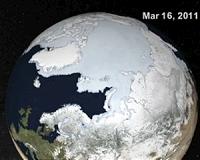 |
Greenbelt MD (SPX) Apr 11, 2011 Recent observations from satellites and ground stations suggest that atmospheric ozone levels for March in the Arctic were approaching the lowest levels in the modern instrumental era. What those readings mean for the remainder of the year is unclear. But what they mean for the long-term is that the recovery from human-induced ozone depletion is an uneven climb. These maps of ozone concentrations over the Arctic come from the Ozone Monitoring Instrument (OMI) on NASA's Aura satellite. The left image shows March 19, 2010, and the right shows the same date in 2011. March 2010 had relatively high ozone, while March 2011 has low levels. The large animation file (linked below the images) shows the dynamics of the ozone layer from January 1 to March 23 in both years. In mid-March, scientists from Germany's Alfred Wegener Institute announced that Arctic ozone levels had been cut in half in the waning weeks of winter, according to a network of 30 ozone sounding stations spread around the region. Data from OMI also confirmed a depletion. OMI is a spectrometer that measures the amount of sunlight scattered by Earth's atmosphere and surface, allowing scientists to assess how much ozone is present at various altitudes, particularly the stratosphere. Ozone is destroyed when chlorine- or bromine-based compounds-especially chlorofluorocarbons (CFCs) -break into their free atoms and combine with the oxygen. That process is amplified when the stratosphere is especially cold, which it has been in recent weeks. "This depletion is not necessarily a big surprise," said Paul Newman, an atmospheric scientist and ozone expert at NASA's Goddard Space Flight Center. "The ozone layer remains vulnerable to large depletions because total stratospheric chlorine levels are still high, in spite of the regulation of ozone-depleting substances by the Montreal Protocol. Chlorine levels are declining slowly because ozone-depleting substances have extremely long lifetimes." The concentration of ozone in the Arctic atmosphere varies greatly from year-to-year, and ozone "holes" do not form consistently like they do in Antarctica. "Last winter, we had very high lower stratospheric temperatures and ozone levels were very high; this year is just the opposite," Newman said. "The real question is: Why is this year so dynamically quiet and cold in the stratosphere? That's a big question with no good answer." Scientists will be watching in coming months for possible increases in the intensity of ultraviolet radiation (UV) in the Arctic and mid-latitudes, since ozone is Earth's natural sunscreen. "We need to wait and see if this will actually happen," Newman said. "It's something to look at but it is not catastrophic." On a global scale, the ozone layer is still on a long-term course for recovery. But for decades to come, there remains a risk of major ozone losses on yearly or regional scales.
Share This Article With Planet Earth
Related Links Ozone Hole Watch Earth Observation News - Suppiliers, Technology and Application
 Arctic Ice Gets A Check Up
Arctic Ice Gets A Check UpGrreenbelt MD (SPX) Apr 01, 2011 Scientists tracking the annual maximum extent of Arctic sea ice said that 2011 was among the lowest ice extents measured since satellites began collecting the data in 1979. Using satellites to track Arctic ice and comparing it with data from previous years is one way that scientists track change in the Arctic system. "For the first 20 years of the satellite record, the average annual maxim ... read more |
|
| The content herein, unless otherwise known to be public domain, are Copyright 1995-2010 - SpaceDaily. AFP and UPI Wire Stories are copyright Agence France-Presse and United Press International. ESA Portal Reports are copyright European Space Agency. All NASA sourced material is public domain. Additional copyrights may apply in whole or part to other bona fide parties. Advertising does not imply endorsement,agreement or approval of any opinions, statements or information provided by SpaceDaily on any Web page published or hosted by SpaceDaily. Privacy Statement |